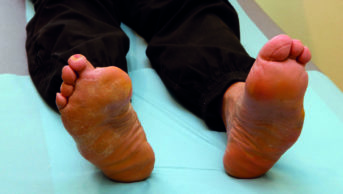
Shutterstock.com
Babies exposed to the HIV drug atazanavir in the womb may have impaired language and social-emotional development at one year, suggests a new study.
Antiretroviral treatment (ART) for HIV containing atazanavir was associated with lower scores for language and social-emotional development in babies at 9-15 months. However, the researchers stress that the absolute differences in scores were small.
The team, from the Harvard T Chan School of Public Health in Boston, Massachusetts, say that because atazanavir is mostly prescribed in combination with tenofovir, it is not possible to separate the effects of the two medicines. “Nevertheless, if atazanavir and tenofovir are commonly prescribed together, these results could still be informative for clinical practice.”
The researchers recruited HIV-infected pregnant women from across the United States, with 917 eligible for assessment. Of the 575 participants who completed the prospective cohort study, just over two thirds started antiretroviral treatment (ART) in the second or third trimester of their pregnancies, with around 20% of patients initiating ART containing atazanavir.
The researchers used a standard neurodevelopmental test for infants and toddlers — known as Bayley III — with a reference score of 100. Language scores were 3.4 points lower (95% confidence interval [CI], -6.2 to -0.5) and social-emotional scores were 5.9 points lower (95% CI, -9.4 to -2.3) in babies whose mothers initiated atazanavir ART in the second or third trimester of pregnancy compared with mothers who initiated ART without atazanavir.
The researchers observed no significant differences between scores of those who started atazanavir-containing ART in the first trimester compared with mothers who started ART without atazanavir in the first trimester.
The researchers acknowledge that their findings, published in AIDS
[1]
(online, 22 February 2016), are unexpected because atazanavir is not readily able to cross the blood-brain barrier. However, they note that the development of the blood-brain barrier is gradual and its integrity can be compromised. The researchers also suggest that elevated bilirubin could be responsible for atazanavir’s effects on development.
Atazanavir is widely used in pregnant women with HIV and “any reports of possible adverse outcomes must be taken seriously”, says Heather Leake-Date, consultant pharmacist in HIV and sexual health at Brighton & Sussex University Hospitals NHS Trust, who was not involved in the study. She adds that further longitudinal data from the children assessed in the study will be of interest, to see if developmental delays persist or resolve over time.
Leake-Date says that because the clinical significance of the findings is unclear “pregnant women who are taking atazanavir should be advised to continue [atazanavir] and to discuss any concerns they may have with their HIV team”.
In the UK, women with HIV are advised to continue the ART regimen they were taking prior to conceiving, provided it adequately controls HIV viral load.
“The mechanisms through which atazanavir may affect language and social-emotional development remain poorly understood,” say the researchers.
ART is recommended during pregnancy for HIV-infected women because it dramatically reduces the risk of HIV transmission to the baby. There have been many studies examining the risk of ART medications to the fetus; most have ruled out any significant congenital effects. However, there are exceptions and the combination of stavudine and didanosine is not recommended.
References
[1] Caniglia E C, Patel K, Huo Y, et al. Atazanavir exposure in utero and neurodevelopment in infants: A comparative safety study. AIDS 2016. doi: 10.1097/QAD.0000000000001052


